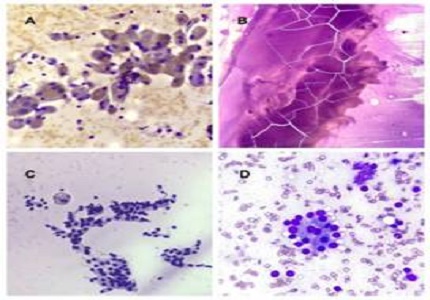FNAC study of thyroid lesions using the Bethesda system
Abstract
Background: The most reliable, safe, cost-effective and accurate way to evaluate thyroid nodule is cytology, which has become the standard of care. As there is a 10% lifetime risk of developing a thyroid nodule, screening thyroid nodules had turned out to become a common medical problem affecting the general population. According to the guidelines of American association of clinical endocrinologists, fine needle aspiration cytology [FNAC] is the gold standard method available for distinguishing between benign and malignant thyroid swelling and is the most commonly performed non-gynaecological cytological procedure.
Aims: To study the cytomorphological features and to classify cytologically the thyroid lesions based on the Bethesda system.
Methods and Material: The present descriptive study was undertaken in a tertiary care hospital for a period of 3 years to analyse the role of FNAC in the diagnosis of thyroid lesions and classify them cytologically according to the Bethesda system.
Results: 40 cases were classified as unsatisfactory, 328 cases as benign, 5 cases as AUS, 23 cases as FN/ HCN, 1 case as SFM and 3 cases as malignant.Out of 328 cases in benign category, 281cases belonged to BFN subcategory which was the most common non-neoplastic lesion of thyroid.The age range of patients presenting with the thyroid lesion was from 7-75 years. Maximum number of cases i.e. 116 were in the age group 31-40 years followed by 95 cases in the age group 21-30 years. Maximum cases in the benign category belonged to the age group of 31- 40 years. Maximum cases [10 out of 23 cases] in the follicular neoplasm category were seen in the age group ranging 21- 40 years. Out of 400 cases, females [359] cases outnumbered male [41] cases contributing 89.75% and 10.25% respectively with male to female ratio of 1:8.7. There was overall female preponderance seen in all diagnostic categories of TBSRTC. 5 cases diagnosed as AUS in our study were according to recommended criteria mentioned in Bethesda system i.e. less than 7%.One case each of PTC, MTC and UTC were seen in malignant category in our study.
Conclusions: The Bethesda System for Reporting Thyroid Cytopathology (TBSRTC) helped to communicate interpretations of thyroid FNAC to referring physicians in terms that are short, concise and clinically helpful and it will also be a source of information for pathologists as well.
Downloads
References
Sclabas GM, Staerkel GA, Shapiro SE, Fornage BD, Sherman SI, Vassillopoulou-Sellin R et al. Fine needle aspiration of the thyroid and correlation with histopathology in a contemporary series of 240 patients. Am J Surg 2003; 186: 702-10.
Nargess G, Shahram H, Mohammad J. Fine needle aspiration cytology of thyroid nodules: correlation with surgical histopathology. Turkish J Endocrine Metabol 2008; 12: 73- 4.
Ray S, Manna AK, Sen S, Pathak S, Chakraborty D, Bhattacharya P. Morphometry of thyroid lesion with cytological and histological correlation. J cytol 2006; 23: 113- 8.
Smadi AA, Ajarmeh K, Wreikat F. Fine needle aspiration of thyroid nodules has high sensitivity and specificity. Rawal Med J2008; 33(2): 221- 24.
Theoharis CG, Schofield KM, Hammers L, Udelsman R, Chhieng DC. The Bethesda thyroid fine-needle aspiration classification system: year 1 at an academic institution. Thyroid 2009; 19:1215- 23.https://doi.org/10.1089/thy.2009.0155.
Jo VY, Stelow EB, Dustin SM, Hanley KZ. Malignancy risk for fine-needle aspiration of thyroid lesions according to the Bethesda system for reporting thyroid cytopathology. Am J Clin Pathol 2010; 134: 450- 6.https://doi.org/10.1309/AJCP5N4MTHPAFXFB.
Mufti ST, Molah R. The Bethesda system for reporting thyroid cytopathology: a five-year retrospective review of one center experience. Int J Health Sci 2012; 6:159- 73.
Basak B, Mondal S, Roy DN, Sinha S, Sinha S. The Bethesda system for reporting thyroid fine needle aspirates: A cytologic study with histologic follow-up. J Cytol 2013; 30 (2): 94- 9.http://www.jcytol.org/text.asp?2013/30/2/94/112650.
Bhagat VM, Tailor HJ, Kaptan KR, Baladawa V, Prasad GH, Saini PK. Diagnostic Role of the Bethesda system for reporting thyroid lesions: effective tool for managing thyroid lesions. Global J Med Research 2014; 14:13- 18.
Kantola VN, Haus C, Hipp J, Zhao L, Jing X. Prospective evaluation of impact of using the Bethesda system for reporting thyroid cytopathology: an institutional experience. J Am SocCytopathol 2015; 4: 25- 9.
Yasmeen K, Arsalla M, Richa DP, Erbaz M, Vinod G, Archana K et.al. Classification of thyroid FNA smears into Bethesda categories and their correlation with thyroid function tests. Sch J App Med Sci 2016; 4: 916- 23.
Salma B, Nazia B, Humaira B, Summiya F, Ruby R, Mir JN et.al. The Bethesda system for reporting thyroid cytopathology: a two-year institutional audit. Int J Cur Res Rev 2016; 8: 5- 11.
Vojjala R, Shankar RT. Study of cytopathological changes in thyroid by the Bethesda system. JEvidBased Med Healthc 2016; 3: 2741-44.
Garg S, Handa U, Mohan H, Nagarkar N. Role of fine needle aspiration cytology in diagnosis and management of thyroid lesions: A study on 434 patients. J Cytol 2008; 25: 13- 7.http://www.jcytol.org/text.asp?2008/25/1/13/40652.
Chandanwale S, Singh N, Kumar H, Pradhan P, Gore C, Rajpal M. Clinicopathological correlation of thyroid nodules. Int J Pharm Biomed Sci 2012; 3: 97- 102.
Kukkar N, Malhotra V, Saluja M. Analysis of FNAC of thyroid lesions. The Internet J Pathol 2013; 15:1- 9.
Park JH, Yoon SO, Son EJ, Kim HM, Nahm JH, Hong S. Incidence and malignancy rates of diagnoses in the Bethesda system for reporting thyroid aspiration cytology: an institutional experience. Korean J Pathol 2014; 48: 133- 9.https://doi.org/10.4132/KoreanJPathol.2014.48.2.133.



 OAI - Open Archives Initiative
OAI - Open Archives Initiative


